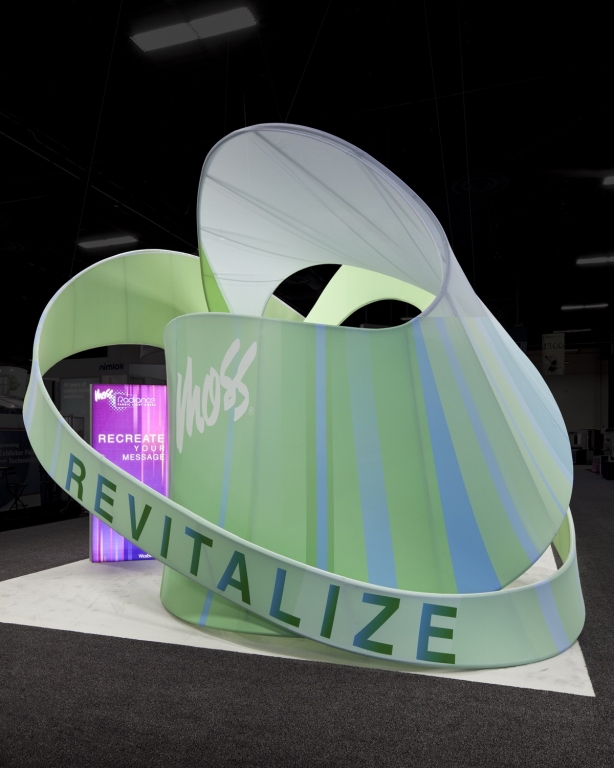Founded in 1975, Moss Inc. (headquartered in Belfast, ME, with production locations worldwide) transitioned its core business from recreational tents to tradeshow displays in the early 1990s. Today, the company operates more than 180,000 sq. ft. of production space, and employs 250.
Jana McQuilkin, the company’s marketing manager, referenced a single technological innovation that has transformed the exhibit-graphics market: silicone-edge graphics (SEG). Such graphics contain a silicone bead that slides within a groove in an extrusion. Thus, SEG systems comprise frames that are completely covered by graphics.
“[SEG] became popular for both aesthetic and economic reasons,” she said. “Rectilinear shapes [polygons with all right-angle edges] became popular, and such designs achieve clean lines with simple, metal extrusions. Also, the graphics are easy to install and remove, which saves on labor costs and makes updating booth designs easy.”
However, Moss countered the rectilinear-shape trend to create a dynamic shape for its 30 x 20-ft., Revitalize booth, which was displayed at this year’s Exhibitor Conference. The company’s NYC-based Pink Design developed the booth graphics. Moss fabricated the booth components with Fisher Textiles’ Performance Stretch fabric, a 5.7-oz/sq. yd. material that comprises 95% polyester and 5% Spandex®. The graphics were printed with the company’s EFI-VUTEk FabriVu® dye-sublimation printer, and installed over Moss’ round-profile tubing. Cables suspended from the roof support the structure. One of the company’s Radiance lightboxes complements the message.
“The booth messaging reflects an important value proposition,” McQuilkin said. “Fabric architecture is a cost-effective way to refresh a company’s image by adding new graphics to existing properties.”
She noted several trends that have altered many exhibit-graphic compositions:
• The use of interactive touchscreens and kiosks to engage visitors – McQuilkin said many exhibitors simply display product images on monitors or iPads in lieu of shipping materials – as well as projection and lighting to more effectively stage products when they’re in booth spaces;
• Adding QR codes to encourage booth guests to virtually connect with the exhibit’s brand;
• And, as always, “green” considerations, such as reducing energy through LED illumination, using materials that reduce petrol consumption (both through specifying material with less PVC, and requiring less fuel to be used for transport) and the use of such recycled-content materials as polyester and aluminum.
Advertisement



 Tip Sheet1 week ago
Tip Sheet1 week ago
 Photo Gallery2 days ago
Photo Gallery2 days ago
 Ask Signs of the Times4 days ago
Ask Signs of the Times4 days ago
 Real Deal1 week ago
Real Deal1 week ago
 Benchmarks6 days ago
Benchmarks6 days ago
 Women in Signs1 week ago
Women in Signs1 week ago
 Photo Gallery1 week ago
Photo Gallery1 week ago
 Women in Signs1 week ago
Women in Signs1 week ago







